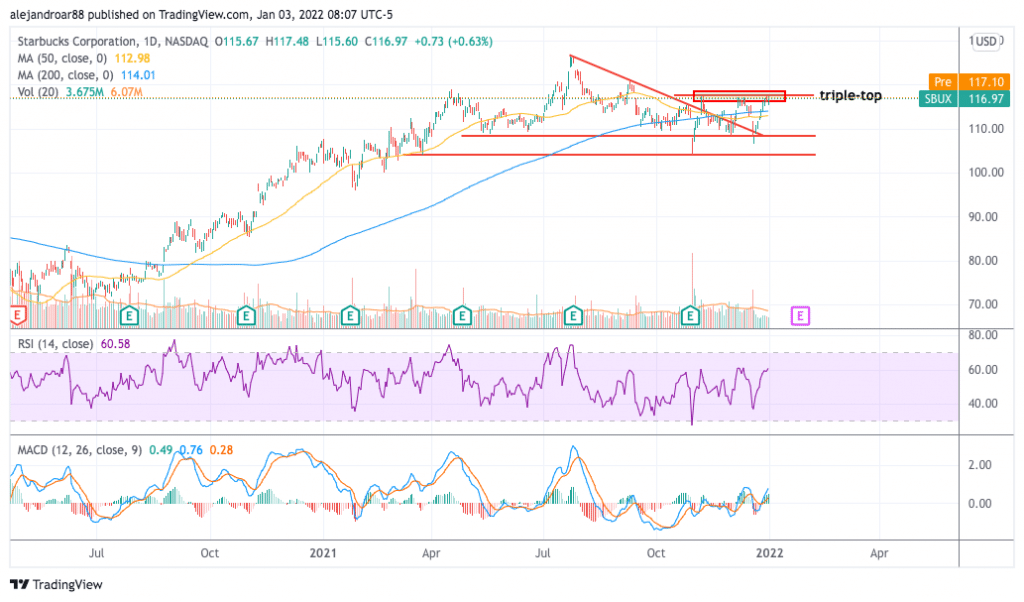Starbucks Stock Up 9% in 2021 – Time to Buy SBUX Stock?
Please note that we are not authorised to provide any investment advice. The content on this page is for information purposes only.
The price of Starbucks stock went up only 9% last year and severely underperformed its broad-market large-cap benchmarks as investors were spooked by the firm’s disappointing numbers in China during the last quarter of the 2021 fiscal year.
Even though the company’s earnings were better than expected in the first three quarters of the 2021 calendar year, revenues missed estimates on two occasions as these factors weighed on the firm’s top-line performance.
Meanwhile, Starbucks has kept struggling to grow its presence and financial performance in China – a country that the market has been deeming as pivotal for the future of the business.
Back in October, the company reported a deceleration in its comparable store sales in the Asian nation amid a resurgence of the virus and this prompted a significant 6% same-day drop in the stock price.
Moreover, on 13 December, the company reported that it will be conducting inspections in thousands of outlets in the country amid a reported breach in food safety standards that led to the closing of two stores.
Finally, the appearance of the omicron variant and its fast spread in multiple nations has been concerning market participants as some countries have moved to reintroduce some restrictions.
The financial performance of Starbucks could be hurt if these measures are adopted by a large number of countries as traffic volumes and average order sizes might drop as a result of store shutdowns and limited store capacities.
What can be expected from Starbucks stock after this disappointing 2021? Is the stock poised to make a comeback? In this article, I’ll be assessing the price action and fundamentals of SBUX stock to outline plausible scenarios for the future.
67% of all retail investor accounts lose money when trading CFDs with this provider.
Starbucks Stock – Technical Analysis

As I highlighted in a previous article about Starbucks, the $100 level was a key support area to watch following the sharp decline that the stock experienced back in October after the firm’s Q4 2021 earnings report came out.
The price slid to $104 per share on the day that the report was published but bounced strongly on the days that followed as investors shrugged off most of the negative news coming out of China.
Meanwhile, even though the latest price action led to a break of the descending triangle formation highlighted in this previous article, the stock has now posted a triple-top formation that could lead to another sharp decline in the following stock trading sessions.
Stalled momentum indicators are favoring a bearish outlook as well as the Relative Strength Index (RSI) has failed to make a higher high on three occasions already.
Moving forward, if the stock fails to climb above the $118 level, chances are that a decline toward the mid-to-low 100s will take place in the next few weeks. This results in a 10% downside risk based on Starbucks’ 31 December closing price of $116.97 per share.
67% of all retail investor accounts lose money when trading CFDs with this provider.
Starbucks Stock – Fundamental Analysis
Starbucks’s sales jumped above pre-pandemic levels in the past fiscal year as they landed at $27.3 billion compared to $24.4 billion the firm brought during the 2019 fiscal year. Gross margins last year also stood near the average at 29% despite the challenging conditions that the business is facing to keep its stores stocked up.
Moving forward, the situation in China will continue to play a key role in shaping the valuation of Starbucks as the country is still considered the most important engine for the firm’s future growth.
With this in mind, any negative news concerning the company’s operations in the Asian country will lead to a revision of Starbucks’s trading multiples and forecasted sales and earnings.
Based on last week’s closing price of $117 per share, Starbucks is trading at 34 times its forecasted adjusted earnings per share for 2022 while offering an unattractive 1.7% dividend yield.
The company’s free cash flow generation capacity is relatively weak compared to its market capitalization, meaning that the firm’s ability to push the share price higher by repurchasing a portion of its outstanding shares is limited.
Moreover, the firm will likely keep deploying more resources in expanding its footprint in Asia and that will limit the rate at which its free cash flows will grow in the future.
The company’s long-term debt is manageable at $13.6 billion on total assets of $31.4 billion including $6.6 billion in cash and equivalents. Therefore, solvency risks are very low.
All things considered, from a fundamental perspective, the outlook for SBUX stock is neutral to bearish for 2022 as the current trading multiple seems to be pricing most of the upside that the business will experience once the pandemic is fully over.






